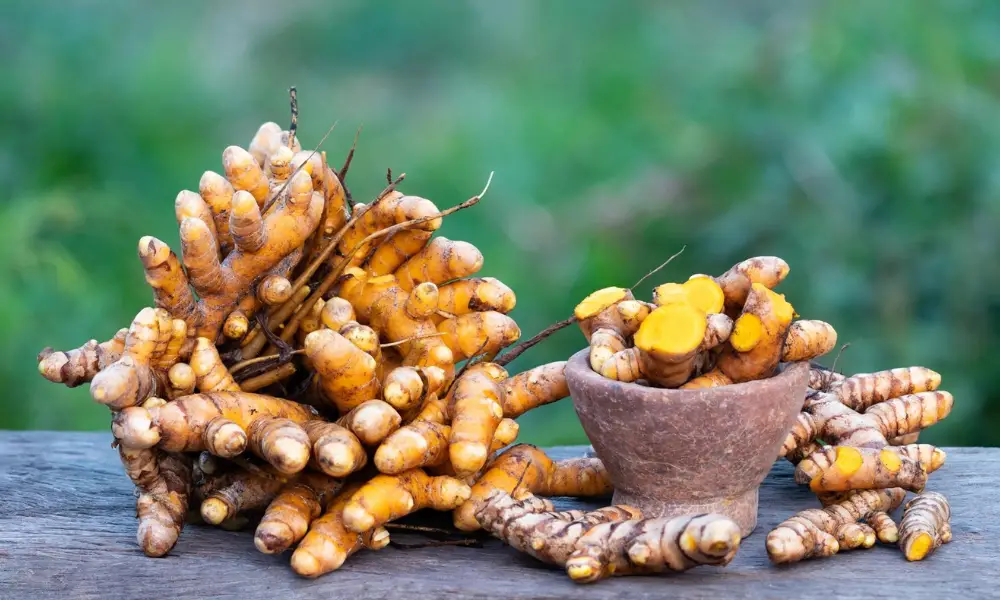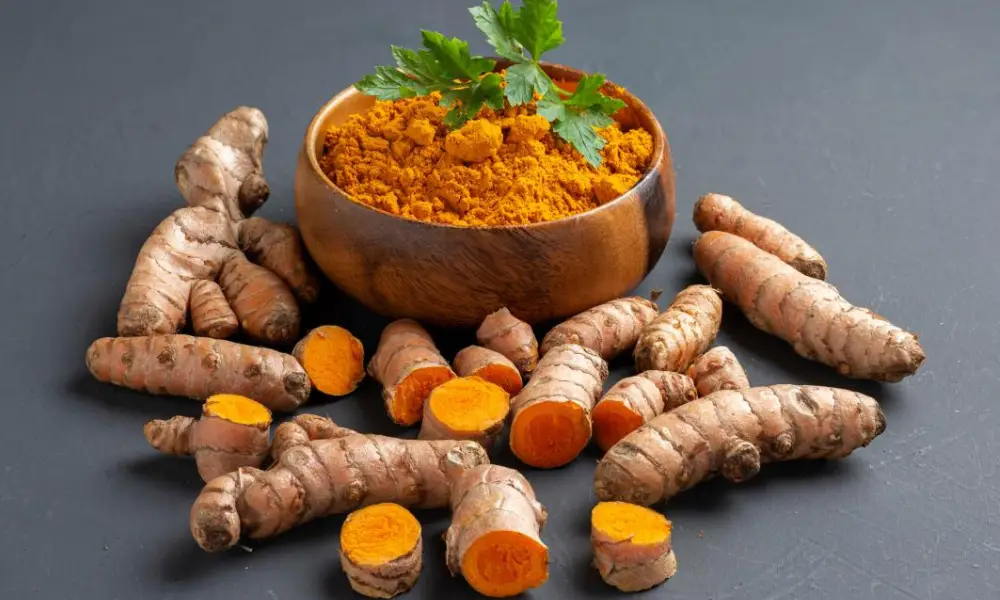You may have wondered how to store turmeric root. It has many great uses and has been used for thousands of years in Indian cuisine. This spice is widely used for its anti-inflammatory properties, as well as its other positive health benefits. Fresh turmeric root is easy to store. It keeps well in the refrigerator or freezer and can be dehydrated into powder if you wish to use it for cooking or baking. If you don’t use it quickly, however, it can be frozen to create dried turmeric powder.

How to Store Turmeric Root?
In the Fridge
If kept dry, turmeric root keeps well in the refrigerator.
The following steps to get going:
- Make use of a brush or your fingers to scrub the turmeric root. Before storing and eating, the turmeric root must be well cleaned, much as other produce. As a result, there are far fewer residues on them when they arrive at your house. You’ll want to get rid of everything, including dirt, pesticides, and bacteria. Keep in mind that if you wash the skin thoroughly, you don’t need to remove it. Only before eating is it removed to aid in the removal of debris and bacteria.
- In order to dry the turmeric root, use a paper towel. Mold growth is the main concern when using fresh turmeric. The easiest method to prevent this is to make sure they are totally dry before putting them in the fridge.
- Keep things in a brown paper bag. A brown paper bag can effectively absorb extra moisture, preventing mold formation on the turmeric once more. No concerns if you don’t have a brown paper bag. Simply place the root in a plastic bag after wrapping it with a paper towel. The paper towel will accomplish the same task as the paper bag in terms of absorbing additional dampness.
- It’s that easy. To ensure that the remaining turmeric doesn’t go bad before two weeks have passed in the refrigerator, you might want to think about freezing it.
How to Make Oven-Made Turmeric Powder?
You can use your oven to cook raw turmeric into a powder that will keep for up to a year rather than throwing away or freezing it.
This is how:
- Wash the Curcuma root. Because you’ll be peeling the skin off to prepare turmeric powder, you don’t need to scrub thoroughly. But quickly rinse the roots.
- Peel the turmeric root’s skin off with a vegetable peeler. Due to its knobby texture, which resembles ginger, turmeric root can be a little challenging to peel. Instead of peeling around these knobs, I find it easier to cut them off. Find a method that works for you, and don’t worry if the root still has some skin on it.
- Slice the root into even, fine pieces. The root will dry faster and more uniformly if it is cut into thin slices.
- Place the slices on a baking sheet that has baking paper on it. Avoid overlap and distribute equally. 2 hours of baking at 200 degrees Fahrenheit in the oven. Slices can be added to a food processor or grinder to be ground into a powder. Please be aware that this could discolor your tools. Put in a spice jar and keep for up to a year in a cool, dark cabinet.
What is the Difference Between Turmeric Root and Powder?
The raw turmeric root is peeled, boiled, dried, and ground to get dried turmeric. Turmeric loses part of its oils and pungency during this process. So, in my opinion, fresh turmeric has the nicest flavor and is ideal for our health. However, turmeric powder also has its uses and might be more practical and much less messy.
Here are some things to think about while purchasing either variety.
Buying Turmeric Root Involves:
A common location for turmeric in grocery stores is next to ginger root in the produce section. Avoid soft, dried, and shriveled turmeric, and choose a piece that is firm.
Buying Turmeric Powder Involves:
Make sure it’s a premium variety. Going to ethnic and specialty spice stores is frequently beneficial since they offer fresher stock that rotates more quickly. The harsh, bitter flavor of less expensive turmeric powder may make you give up on this root altogether.
What are the Uses of Turmeric Root?
It’s time to start using turmeric in your cuisine now that you are fully informed about how to buy and store it.
I’ll list some of my favorite fresh turmeric dishes below. However, I want to give you some tips on how you can use fresh or frozen turmeric so that you can become the chef in your own home.
- Smoothies and juices. The flavor of turmeric root is potent and can give your beverage a boost. The health advantages of turmeric’s anti-inflammatory properties can be obtained by using it regularly.
- Brewed tea. On the stovetop, bring some water and a piece of turmeric root to a boil. Simmer for 10 minutes at low heat. For a delectable ginger-turmeric tea, I also like to add ginger root to the kettle.
- Latte with golden milk. Over the past few years, their popularity has soared. They are produced by combining turmeric root, nutmeg, and cinnamon with plant-based milk. One of my favorite dishes is this one.
- Turmeric powder can be substituted in recipes for raw turmeric. One teaspoon of powdered turmeric is equivalent to one inch of fresh turmeric root and one tablespoon of grated turmeric. Although it tastes greatly grated on roasted vegetables, added to soups, or used in Mediterranean dips, it works best in curries and Indian food.
What is the Difference Between Fresh Turmeric and Dried Turmeric?
Fresh Turmeric
Fresh turmeric rhizomes, also known as roots, resemble ginger, another related relative. Similar to ginger, fresh rhizomes taste more vibrant than dried ones. The earthy, spicy, and slightly bitter meat of turmeric has a vivid orange color. If the fruit is particularly young or mature, you might want to remove the skin before using it. Similar to ginger, turmeric can be shredded with a Microplane or cheese grater, juiced, or added to smoothies. It can also be cut into coins, matchsticks, or cubes.
The produce area of well-stocked supermarkets, health food stores, and Asian and Indian supermarkets all carry fresh turmeric. Avoid soft, dry, or shriveled rhizomes and choose those that are firm. Fresh turmeric can be frozen for several months or kept in the refrigerator for one or two weeks in a plastic bag or airtight container.
Dried Turmeric
The rhizomes are peeled, boiled, and dried to produce dried turmeric, which is then sold whole or powdered.
During the drying process, turmeric loses part of its pungency and essential oils, but it can still add warmth and color. Use whole fingers and ground them with a Microplane or spice grinder as needed for the greatest flavor.
Look for ethnic and specialty spice shops when buying dried turmeric because they frequently have more recent inventory and a quicker turnover than normal supermarket stores. When comparing quality indicators, aroma frequently outperforms color, which can range from yellow to orange. For up to a year, keep dried turmeric in an airtight container in a cool, dark location.
What are the Health Benefits of Turmeric Root?
Medicinal Bioactive Substances
However, turmeric doesn’t contain a lot of curcumin. It’s about 3 percent of the total weight. The majority of investigations on this herb use turmeric extract with dosages typically surpassing 1 gram per day, with curcumin being the main component.
To achieve these levels alone by adding turmeric as a spice to your meals would be quite challenging. Because of this, some individuals decide to use supplements.
Curcumin is not well absorbed into the bloodstream, though. Curcumin’s bioavailability, or how quickly your body absorbs a chemical, must increase for you to benefit fully from it.
Consuming it with black pepper, which has piperine, is beneficial. The natural compound piperine increases curcumin’s absorption by 2,000%.
In actuality, piperine is present in the greatest curcumin pills, which significantly increases their potency.
Additionally fat soluble, curcumin disintegrates and dissolves in fat or oil. Therefore, it can be wise to take curcumin pills along with a meal that has a lot of fat.
Reference: Bioactive Compounds of Turmeric
Increase in Antioxidants
The body’s ability to produce antioxidants can be improved by turmeric.
One of the mechanisms thought to be responsible for aging and many diseases are oxidative damage.
Free radicals, extremely reactive molecules with unpaired electrons, are involved. Important chemical molecules like fatty acids, proteins, or DNA often react with free radicals.
Antioxidants are mostly helpful because they shield your body from free radicals.
Due to the chemical makeup of curcumin, it is a powerful antioxidant that has the ability to combat free radicals.
Reference: The anti-oxidant activity of turmeric
Viral Illnesses
You might want to drink some turmeric tea the next time you feel unwell. Herpes and the flu are just two of the viruses that curcumin may help you fight off. (However, most of the study on this was conducted in a lab, not on humans.) The odd cup of tea won’t be a panacea because turmeric only contains approximately 3% curcumin and your body has trouble absorbing it.
Elevated Cholesterol
There is conflicting evidence on turmeric’s potential to keep your heart healthy. While some research determined that turmeric has no impact, others discovered that it helps lower LDL “bad” cholesterol. The potential benefits of turmeric for protecting the heart are still being studied by scientists. According to a short study, those who have undergone bypass surgery may benefit from turmeric’s ability to prevent heart attacks.
What is the Best Place to Buy Turmeric Root?
Cooks became more aware of the benefits of using fresh turmeric rhizome for its color and flavor as Asian foods gained popularity in Australia and the United States in the 1980s. Specialty produces retailers, especially those that serve the Asian market, frequently carry fresh turmeric. The rhizomes must be supple, clean, and firm. Fresh turmeric can be kept for up to two weeks by storing it in a cupboard in an open jar alongside fresh onions and garlic. Asian produce markets also have young delicate shoots for Thai recipes and turmeric leaves, which are utilized in Malay and Indonesian cuisine.
Conclusion
After harvesting the turmeric root, you can freeze it for future use. Store turmeric in the refrigerator to avoid mold. When not in use, wrap it in a paper towel to avoid moisture accumulation. To freeze it, place it in a freezer bag with a date. Once frozen, it will keep for up to six months in the fridge. To prevent it from spoiling, make sure the bag is airtight. When using turmeric, always store it in its original packaging, as any leftover root may spoil.
